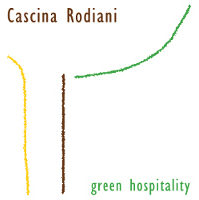At Cascina Rodiani we only use solar and biomass (wood and wood pellet) energy to warm up water we need for heating, cooking and personal hygiene. That’s why we are CO2-free as far as the basic needs are concerned. This post will be about the firewood cycle production.
When the biomass decomposes in nature, it releases the same amount of CO2 that it would release if it was burning, so it is considered CO2-free. Plants absorb CO2 and produce oxygen, a waste for them, but very important for us and all the other species (Nicholas Theodore de Saussure’s discovery in 1804). We can hence definitely say that without CO2 there will be no life.
We manage our woodland according to our needs: to fuel the cooker, the living room fireplace, the wood-fired sauna and the wood-burning furnace but also according to the capacity of the wood to regenerate, always trying to preserve the landscape and the utilities. We have to consider when to chop down trees, each species’ drying time, the different wood size and finally think about the waste. Each species dry in a different time and well dried wood is crucial to reduce toxic emissions.

Branches and leaves are our main green waste but also the bark produced while cutting trees, as well as the ash resulting from combustion. We mince all the green parts coming from the hedge trimming, the pruning or the vegetable garden and put them in the compost heaps that become humus approximately one year later. The dried branches and trees are left in the wood for the necrophagous insects (Lucanus cervus is the most important one). The Cascina and its land are in a rich natural area of National interest, inside the Regional Park Spina Verde.
We also mince the barks and use it for the flower beds and pots mulching. The ash goes both in the wood, in the vegetable garden and in the compost heaps. It’s a circular system in which we give back the organic matter we extract.
We follow the biodynamic calendar to decide when to cut plants. We really trust it because we saw the difference of “water” in trees and plants between cutting it in an ascending or descending moon (not crescent and waning moon): for good dry wood you have to cut trees in descending moon.
Now there are too many trees. This once abandoned land gave new life to the wood: a lot of weak tight high trees popped up overly shading the undergrowth. Every year the wind or the snow contribute to the selection wrecking and eradicating trees though without deciding what to break down, where and neither when.
Birches are always less and weaker: they are pioneering trees that will be soon replaced by long lasting species. The larch as well is slowly disappearing in this area and moving to higher altitudes.

In our surroundings you can find wild chestnut trees, scots pines, black pines, some spruces in the wetter areas, field maples, oaks, walnut trees, ash trees and some varieties of beech are curiously popping up. But also the non-native robinia and paper mulberry, which, as every successful colonizer, are aggressive and invasive.
We wanted to tell you about the wood because it is our main activity during cold months when there are no tourists and the Cascina is closed. Here natural gas is not available, neither do we have LPG or diesel tanks. If we want heating and hot water, we have to think about it at least one year in advance. We work hard trying to do our best, balancing comfort, the changing landscape and nature.
Samuel




